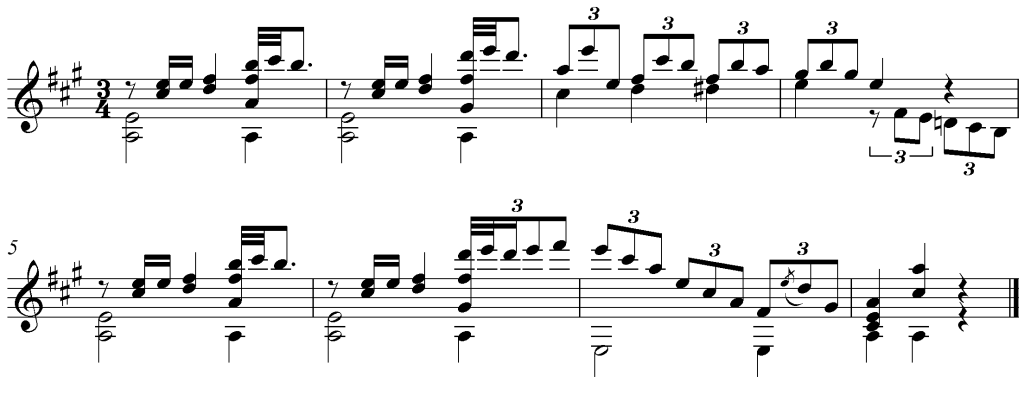
The CAGED System: Part One
This overview article will delve into the CAGED system, what it is and how it works. Highlighting how it supports learning the fretboard and what it can do for a Classical guitarist trying to memorize pieces. Free download of this posts handout at the bottom of the page.
First however lets introduce the system and by the end of this article get you playing 5 chords across 12 frets in 24 keys. The CAGED system is a method (one of many I might add) that is utilized, mainly in the Rock guitar world, for learning to solo and improvise. This post will help illuminate its use for classical guitar as it is one of the most straightforward methods for organizing and understanding the fretboard. Why?
It is based on only 5 chord shapes:
C A G E D
hence the name.
So what does it have to do with the Classical guitar? Well, consider the below excerpt from the B section of a very Famous Mazurka. How would you deconstruct these 8 bars? Play through and time yourself. Can you articulate in words what Tarrega is doing on the fretboard? How long did it take you? If the answers come naturally and easy, don’t bother reading further, go grab a cuppa. However if you could not put into words what is happening on the fretboard with ease, please read on.

The CAGED system aids memorizing pieces, especially in remote keys and helps in clarifying a composers intentions, especially when physically deconstructing their music. More importantly it really helps you learn the fretboard properly in all key signatures. If you have played Tarrega or Barrios et. al., chances are you have already played through parts of the system as both composers used these shapes frequently in their pieces. So lets dive in and learn how 5 chord shapes will help you learn 24 keys.
First: can you play those 5 chords from above in open position; cowboy style?
Here is a helpful hint (and what CGRocks is really all about). If you rearrange the chords into the progression: C G D A E, you can now strum one of Jimi Hendix’s super famous songs which will help when learning your chord shapes.
Second: try and move those 5 chord shapes into, say the 5th position. Can you still play those 5 chord shapes?
This time they should all be barre chords, see below for illustration. Still the same shapes, just with a different set of fingers. The five shapes should be easy to spot, maybe not so easy to execute. Try the Hendrix progression from above. Can you still play it?
We are now going to string the shapes across the fretboard starting back at first position C major. Connecting each shape up; last note of the current chord becoming first note of the next chord. Thus converting the Fretboard into one long series of the C major triad (with a proviso on the D shape). See below for fret positions; the shapes should now be easy to spot and execute.
Note: Once out of first position it is just a series of Barre chords that utilize the A G E D shapes. Easy?
Yes, it is and well….
…in essence that is all the CAGED system is: a series of chord shapes across the fretboard. It is also the ability to play in one position or move across the fretboard in one key or many.
That’s it? Job done? Not quite!
You have just learned the CAGED system basics if you can string those chord shapes across the fretboard from C to D. However now you need to be able to use them in other keys.
So……..lets pick another key, say G major. What is the lowest sounding G note on the fretboard?
Third fret, right! Now work out the chord shape in that position, open G shape and…
…well start connecting the chords up from it. G shape goes into E shape which goes into D shape which (and here is that proviso from above) notice D shape does not quite connect last note to first note into the C shape. See below for further illustration, especially focusing on the 7th position.
Pick another open string chord, say A major and begin to play up through the shapes. A shape goes into G shape into E shape etc. etc. It does not matter at which chord in the system you start they always link into one another, not unlike a jigsaw puzzle.
There you have it, 5 chords across 12 frets that now need to be practiced in all 24 keys.The beauty of the system is you can start at any chord and cycle round them they always follow each other neatly on the fretboard. I have concentrated on major chords however all the shapes can be converted into minor chords by lowering the major third within each shape.
Practice Tip
Try playing through each shape as an arpeggio connecting them up and down the fretboard. To learn it completely I suggest doing this key by key in a cycle of 5 (or 4). So convert the entire fretboard into CAGED arpeggios starting with the key of C then move round the cycle of fourths (left) or the cycle of fifths (right). See below for further illustration.
Finally a quick check list for manipulating your new found CAGED system knowledge.
- Find the lowest note of key. (Generally 1st position and on strings 5 OR 6)
- What Chord shape is there? (Cowboy chord or barre chord?)
- Cycle through shapes up the fretboard using arpeggios.
Now if we come back to that Tarrega excerpt, this time with the TAB underneath. What key are we in? Can you now spot the chord shapes he is using?
 Here it is again this time stripped of all ornaments and the chord shapes filled out. Apart from two scale runs the majority of this section is based on only 4 major chord shapes: A E C G; and 1 minor shape: Em. Notice how Tarrega used the A major chord in 3 shapes across the fretboard. This short excerpt is the perfect example of the analysis required to memorize and understand a pieces form. Try it with a piece you know intimately.
Here it is again this time stripped of all ornaments and the chord shapes filled out. Apart from two scale runs the majority of this section is based on only 4 major chord shapes: A E C G; and 1 minor shape: Em. Notice how Tarrega used the A major chord in 3 shapes across the fretboard. This short excerpt is the perfect example of the analysis required to memorize and understand a pieces form. Try it with a piece you know intimately.
The next two CAGED overview installments will cover the scales that are associated with each shapes, as well as how to utilize it fully to memorize a piece or even your scale shapes for any key.
Please take note: in all the above explanation I have carefully separated the descriptions: D shape opposed to D major. Do not get the two confused! Shapes are just shapes which can be moved. D major is the key, the chord or even the chord root.
CODA
Recently the CAGED system has come under fire in various forums and posts on the internet for not fulfilling its role as the easiest method for learning to improvise. Most of these posts completely miss the point: the CAGED system only helps organize the fretboard into a wire frame of box shapes and that once learnt in a position or key then require extra effort to be played across or through; even just forgotten. So you need to practice it until you get to the stage where you can just “see” the key and move through all its associated shapes…
Or in the immortal words of Nobutada
“No Mind”.
Free Download Below
Free download of the CAGED system chords in C across the fretboard and the Cycle chart with each chord associated with the key.










